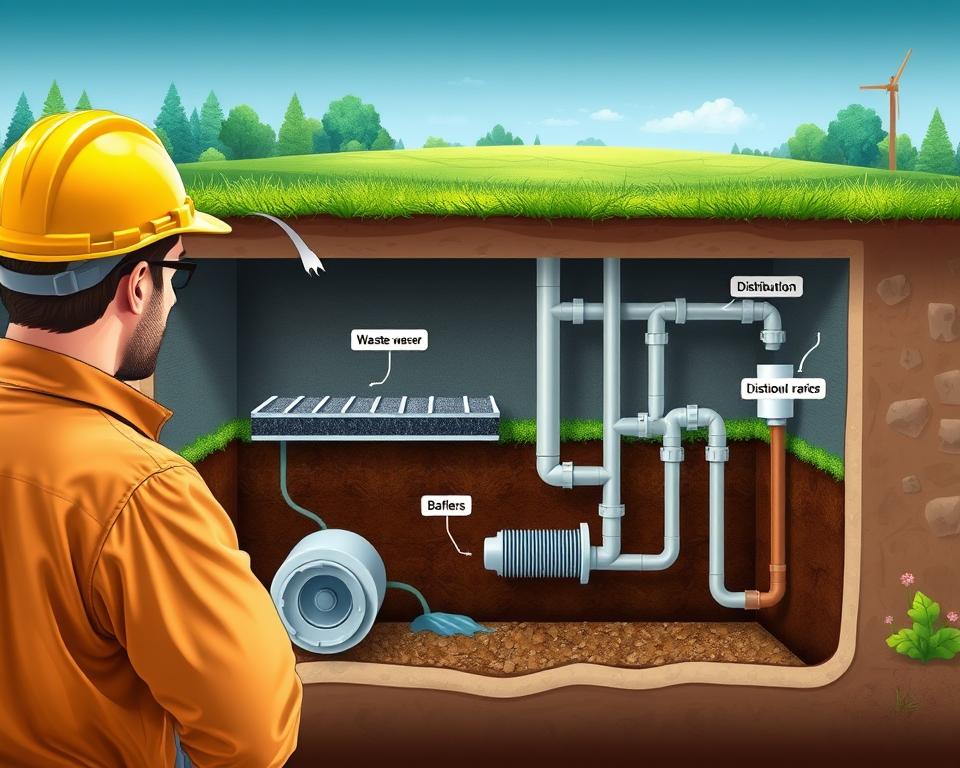Septic System Maintenance
Ever pondered concerning the ramifications of overlooking septic system care? For those who use these installations for sewage handling, skipping routine care can result in significant bills. It also poses hazards to both health and the ecosystem. Pumping your septic system is more than a simple task; it’s crucial for guaranteeing your home operates smoothly. By regularly pumping your septic tank, you halt sludge accumulation and prolong the lifespan of your unit. This preventive approach allows you to dodge any unwanted scenarios. Find out the importance of septic tank care and the process involved with septic pumping.
Principal Conclusions
- Scheduled septic system pumping is essential for preventing hefty restorations.
- Ignoring upkeep can result in dangerous conditions for your family.
- Knowing your septic system helps in proper care.
- Indicators of a malfunctioning septic system should be identified promptly.
- Professional services can support in keeping peak tank health.
Understanding Your Septic System
A septic system is an efficient on‑property method for treating wastewater. It mainly consists of two components: the septic tank and the absorption field. Both are integral for ensuring proper sanitation and preserving the surroundings.
The septic tank collects wastewater from your home. There, solids sink to the bottom, and liquids rise to the top. Naturally occurring bacteria within the tank break down the organic material, making the outflow easier to treat. This initially processed wastewater then travels to the drainfield for further purification by the earth, completing the cleanup.
It’s crucial for homeowners to understand the dynamics of their septic system. Knowing how the septic tank and leachfield operate in tandem can result in enhanced system care. This insight promotes effective maintenance practices, ensuring the system’s robustness.

Value of Regular Septic System Cleaning
Consistent maintenance of the septic system is key for household and environmental health. If overlooked, untreated wastewater can leak into your yard. This escape may result in subsurface water contamination, creating dangerous conditions. By keeping the septic system clean, you safeguard your family and the ecosystem.
It’s suggested to pump the septic system every three‑to‑five years, based on how much you rely on it. Such upkeep is not just eco‑friendly; it heads off big bills. A septic system that’s well‑maintained works more efficiently, delivering a safer household and a safer natural world.
Indicators Your Septic Tank Needs Service
Homeowners need to spot signs that their septic tank may need pumping. Key symptoms to monitor consist of:
- Slow drainage in washbasins, bathtubs, and lavatories
- Foul stenches near the absorption area
- Wastewater overflows in household plumbing
- Persistent damp zones or overly green patches of grass above the septic system
It’s critical to spot these signs early to prevent major septic tank issues. Routine inspections are vital. They find issues before they escalate to pricey repairs. Inspecting your system consistently ensures it operates well and survives longer.
Staying alert and acting swiftly are essential for septic system maintenance. By observing these red flags, you can keep your septic system in prime condition.
Septic System Pumping Schedule
Pumping your septic system on schedule is central to maintaining your home’s plumbing in top shape. Specialists generally suggest servicing the septic tank every three to five years. However, this can differ according to the capacity of your family, how much water you use, and the size of your tank.
If you have a high‑occupancy household that consumes more water, you could need to service the system at shorter intervals. Tracking your water usage can let you determine if you need to modify your service schedule.
All in Sanitation recommends setting up a steady pumping schedule that fits your household’s unique needs. Adhering to a routine maintenance routine helps keep your septic system running efficiently and avoids hefty fixes.
Septic System Cleaning: Top Tips
For a septic system to remain robust, homeowners must practice important habits. It’s vital not to flush items that won’t break down; doing so prevents blockages and ensures the system functioning properly. Similarly, reducing household chemical usage keeps the required bacterial balance. These measures are vital for the system’s longevity and efficiency.
Being proactive with routine inspections is crucial. Setting up periodic checks can catch issues quickly, allowing for immediate repairs. Additionally, conserving water through stopping leaks and mindful usage supports septic tank health. These steps ensure the system runs smoothly for decades.
It’s also essential not to drive on the absorption area. Keeping this area clear allows it effectively process effluent, protecting your system from damage. Following advice from professionals like All in Sanitation also improves septic system care.
The Steps of Septic Tank Pumping
For homeowners, grasping the septic system maintenance process is key. A licensed septic pumper should conduct regular septic tank pumping to ensure your system functioning efficiently. The first step is checking the tank’s status to determine when it needs pumping.
A septic tank needs pumping once the sludge take up about 1/3 to one‑half of its capacity. The licensed septic pumper will then extract these solids. This procedure preserves the system’s performance. Furthermore, the visit may involve inspecting the tank for possible issues, facilitating immediate fixes.
Holding a log of each pumping visit is advisable. This log helps homeowners track their septic system’s upkeep, and is useful if selling the property. Regular septic system maintenance boosts its service life and functionality, heading off expensive fixes later on.
Septic Tank Inspection: What to Look For
Routine inspections are essential for your septic system’s health. Using a comprehensive septic tank inspection checklist can uncover potential issues early. Inspections should be done by a qualified technician every 1‑2 years. They will gauge sludge levels and the floating layer during this visit.
Examining the internal baffles and filters is also crucial. These elements are essential for your septic system’s efficient operation. Finding seepage or malfunctions quickly can prevent large repair costs. Forward‑thinking actions, like following an inspection checklist, boost your system’s lifespan and effectiveness.
Specialized Septic System Services
Using specialized septic system services is essential for your septic system’s integrity. By partnering with a company like All in Sanitation, you make sure that experts handle the cleaning, check‑ups, and fixes carefully. Licensed septic professionals possess special know‑how, allowing homeowners to keep the system’s peak functionality over the years.
Upkeep by qualified pros lowers the likelihood of sudden malfunctions and costly fixes. These services include comprehensive inspections that check the system’s state, pinpointing possible issues early. Adopting this proactive stance greatly prolongs your septic system’s life.
At the end of the day, entrusting your septic system to licensed professionals offers confidence. Partnering with companies such as All in Sanitation leverages their experience. It secures the health of your tank, creating confidence in its maintenance.
Septic System Maintenance Hints for Homeowners
Homeowners have the capacity to maintain their septic systems functioning reliably. Applying effective care strategies significantly boosts their operation. Introducing easy tweaks to water habits, like reducing excess use and staggering the use of appliances, decreases pressure on the system.
Adding low‑flow fixtures in your bathrooms and cooking areas greatly helps septic durability. These fixtures cut down water use without hurting functionality. Skipping garbage disposals is prudent too, as they lead to more solids in the system, requiring more frequent upkeep.
Routine inspections and adhering to a sound maintenance routine will extend your septic system’s lifespan. Being mindful of everything that flows into your drains is key for preserving a healthy septic environment. By practicing these habits, you’ll significantly boost your septic system’s performance and lifespan.
Common Septic System Repairs
Septic systems may experience various troubles over time, necessitating repairs. Typical faults involve leaks, faulty baffles, and drainage issues in the drainfield. By recognizing the signs at an early stage, homeowners can resolve them rapidly, keeping their system remains in good condition.
Usual repairs consist of:
- Replacing damaged parts to restore system integrity
- Repairing or substituting cracked conduits to avoid leaks
- Unblocking plugged lines to ensure proper drainage
Fixing septic troubles promptly not only lowers outlays over time but also prolongs the system’s lifespan. Regular check‑ups and maintenance can help prevent these issues, supporting the upkeep of a sound septic system.
Final Thoughts
Preserving your septic system healthy is central to planetary and personal well‑being. Consistent pumpings and inspections avoid expensive repairs and dangers. Being proactive with septic care conserves resources and lowers stress.
Engaging professionals like All in Sanitation guarantees high‑quality upkeep adapted to your needs. Their knowledge aids detect issues promptly, preventing significant troubles and emphasizing the need for routine inspections.
Adopting effective habits for septic maintenance promises long‑term system effectiveness. A small amount of maintenance now ensures a healthier septic system in the future.

